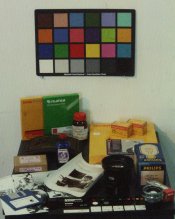Stephen Frizza
Member
- Joined
- Mar 2, 2007
- Messages
- 1,464
- Format
- Medium Format
I have recently been playing around with exposing black and white film through RGB and RYGCB screens with some reasonable success. I have then been reversal processing it and re registering it with the screen it was shot through to produce a colour transparency. A sample of the result is attached.
Well I have been thinking if an integral emulsion (like is found in polaroid and Fuji instant or the impossible products) were to re engineer and the product made to have an RGB or RYGCB screen rather than clear plastic over the image monochrome panchromatic emulsion below it, could it be a new approach to making a colour instant product?
I understand light transmission is Key to the above mentioned principle so I am thinking the emulsion would need to be either on an opaque backing like duratrans to allow light to pass though or otherwise the base would need to be a highly reflective base. Either way the resulting product would be
like an autochrome / dufay / polaroid but as a print material not a film.
Surely this would be a simple method to make a colour instant print product?
(I acknowledge there really isn't anything simple about instant film products)
Its just my mind wandering and thinking about my latest tests .....any thoughts?
~Steve
Well I have been thinking if an integral emulsion (like is found in polaroid and Fuji instant or the impossible products) were to re engineer and the product made to have an RGB or RYGCB screen rather than clear plastic over the image monochrome panchromatic emulsion below it, could it be a new approach to making a colour instant product?
I understand light transmission is Key to the above mentioned principle so I am thinking the emulsion would need to be either on an opaque backing like duratrans to allow light to pass though or otherwise the base would need to be a highly reflective base. Either way the resulting product would be
like an autochrome / dufay / polaroid but as a print material not a film.
Surely this would be a simple method to make a colour instant print product?
(I acknowledge there really isn't anything simple about instant film products)
Its just my mind wandering and thinking about my latest tests .....any thoughts?
~Steve











